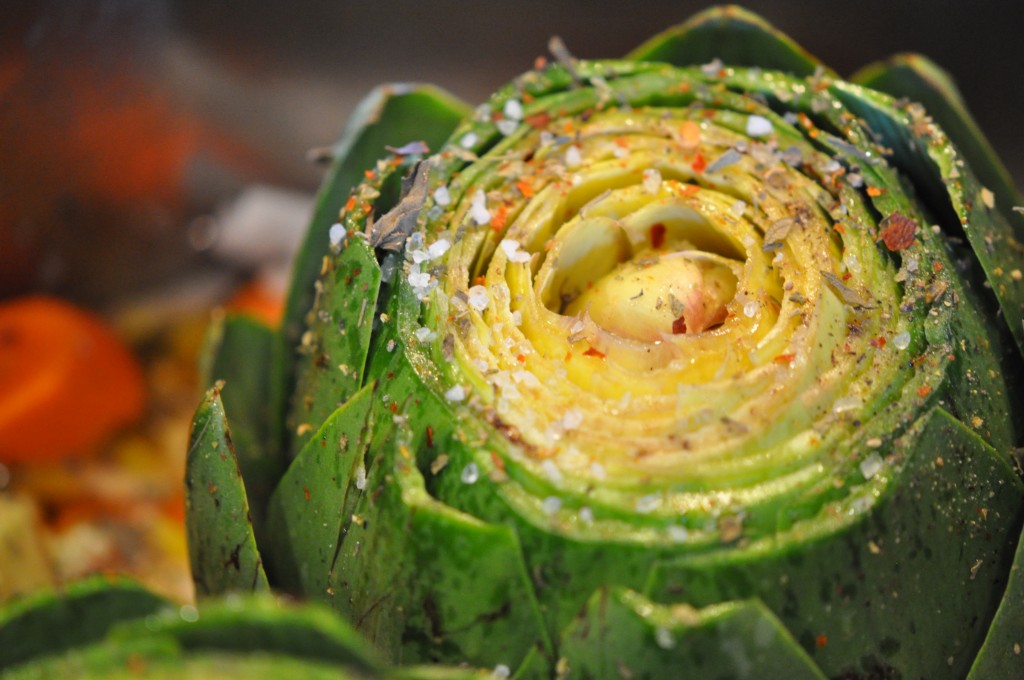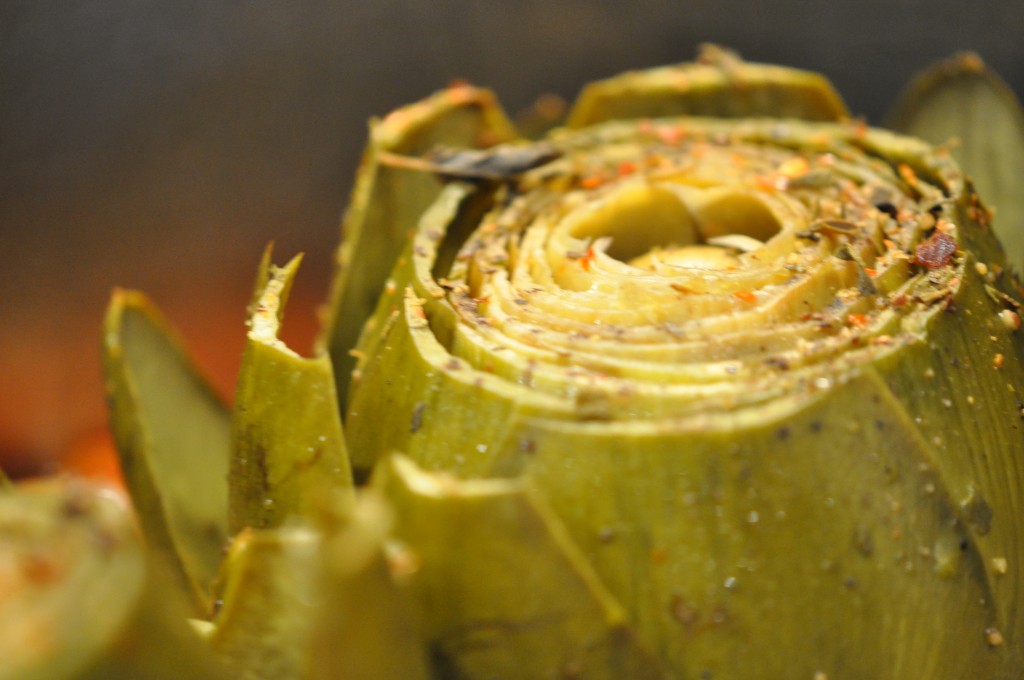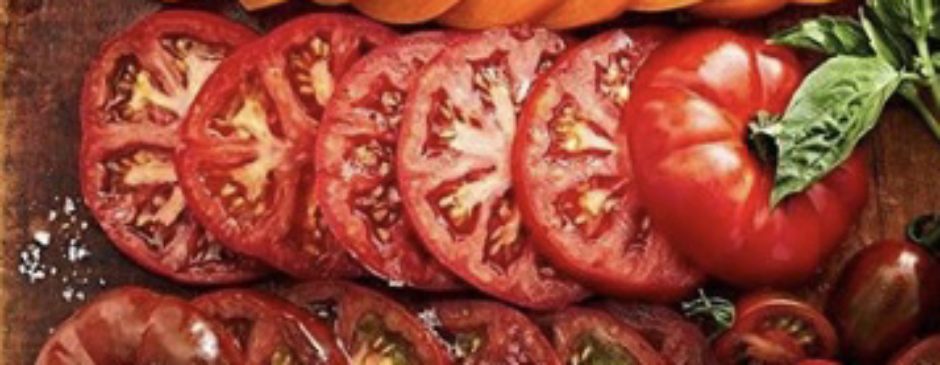Braised Artichokes

Artichoke Before Braising

Cooked Artichoke
Artichokes were a part of my growing up food. Never was there a question about these thistly cactus looking vegetables. I can’t ever remember not having them at least once a week when they were in season. I find it hard to comprehend the fact that most people have never eaten an artichoke let alone cooked one. My life long friend Diann’s mother was another person who very often had artichokes cooking. We took them for granted.
Artichokes are still a part of my diet and I serve them most often as a main course. I don’t need to have anything else with them since my focus is on getting every bit of this wonderfully odd vegetable into my stomach. The preparation I have here has the chokes braised with carrot, celery and onion, dried herbs, XVOO, wine and chicken stock. The vegetables are served with the chokes and make a wonderful accompaniment since they pick up the flavor of the artichoke.
Eating an artichoke can be compared to opening a gift: You take the wrapping off the gift, which in this case are the leaves, one by one to get to the surprise inside – the heart. The heart is the most delicious and luxurious surprise in this gift. You can savor the gift by first sliding the bottom of each leaf between your teeth. This gives you a preview of what the heart has to offer. Sometimes, after a only a few leaves, I can’t wait to devour the heart and I will tear into the artichoke by ripping off the leaves and going straight for it. You have to experience this to know what I am talking about. But the heart can play a mean trick on you with the choke. This fuzzy, prickly center of the heart needs to come out before you can eat the heart. It’s much easier to take it out once it’s cooked, just don’t forget to do it. The easiest way to remove the heart after it’s cooked is to use the tip of your knife to remove the “spiky, furry, indigestible attached to the heart thistle”. I know that most people who do know how to cook an artichoke take the thistly choke out of the center of the heart before cooking and then stuff them. I don’t especially like to go through all of the trouble of stuffing because I enjoy the artichoke as is. If not stuffed it is super easy to remove the choke after it’s cooked and you are eating it.
Right now Artichokes are in season and plentiful at the market. Artichokes originated in the Mediterranean and were brought to the United States in the early 1900’s to California. Artichokes are grown in Castroville, California, and supply 100% of North America. If you are ever in that area at this time of year, treat yourself to a visual experience. They grow in fields alongside the highway and are a beautiful sight to see.
Serves 4
4 Large Globe Artichokes
1 Whole Fresh Lemon to Acidulate Water
6 Garlic Cloves, Crushed
1 Large Spanish or Vidalia Onion, Thinly Sliced
4 Large Carrots, Peeled and Sliced Crosswise into ¼” Slices
4 Celery Stalks with Leaves, Sliced Crosswise into ¼” Slices
½ Teaspoon Dried Oregano
½ Teaspoon Dried Basil
¼ Teaspoon Dried Thyme
½ Cup XVOO
½ Cup White Wine
1 Cup Homemade Chicken Stock or Canned Low Sodium Chicken Broth
1 Teaspoon Coarse Sea Salt
½ Teaspoon Freshly Ground Black Pepper
Pinch of Crushed Red Pepper Flakes
To prepare the artichokes, have ready a bowl of cool water with the juice of one lemon and the rind of that lemon. (Alternately you can use 1 Teaspoon Pure Vitamin C powder instead of the lemon. The lemon or VC will keep the exposed part of the artichoke from oxidizing and turning gray.)
Remove the stems of the artichokes by cutting close to the bottom of the artichoke. Peel the tough outer skin from the stems and place in the acidulated water. Pull the two bottom rows of leaves away from the artichoke. Cut off the top third of the chokes. With a pair of scissors snip the thorny ends of the rest of the leaves and place the artichokes in the acidulated water.
In a large roasting pan or Dutch oven large enough to hold the artichokes standing straight up, place the garlic, onion, carrots and celery. Put the artichokes on top of the vegetables and sprinkle both the vegetables and the artichokes with the dried oregano, basil, and thyme.
Pour the XVOO, white wine and chicken stock over the chokes being sure some of the liquid and dried herbs go into the leaves. Evenly sprinkled the salt, pepper and pepper flakes over the vegetables and artichokes.
Over high heat, bring the liquid to a boil. Reduce the heat to simmer and cover the pan with a lid. Braise the artichokes for 1 hour.
To test for doneness, pull a leaf or two from each artichoke and if they come out with no resistance, the chokes are done. Remove the chokes from the pan and over high heat reduce the liquid by half.
Place the vegetables and liquid on a large serving dish with the artichokes on top and serve immediately.
A FEW WORDS ABOUT THE BOOK: I have been diligently working on my book “It’s All About The Food” I am in the process of organizing the recipes and the sections of the book. When I started this project a couple of years ago I had no idea what I was getting myself into. This is the most difficult thing I have ever done concerning food and cooking. Even the airplane hanger sit down dinner for 350 people wasn’t this hard. I had direction, organization, a lot of very qualified people working and it was an easy event for me to pull off. Don’t get me wrong, there were many sleepless nights and a lot of very, very hard work was put into the event. But this book writing thing is beyond anything I ever believed it would be and taking way more time to complete than I thought possible.
I never really wondered how chefs and cooking show personalities got there books done so fast and put out so many books back to back. They have a staff of writers, organizers, food testers and all of the rest of the people to put their books together. Plus most of them are nationally and/or internationally well known. So often I would hear about people like me, not well known and with no staff to help write the books, taking years to write their cookbooks. I didn’t understand that then but I sure do now.
I am close to having this labor of love complete but I know I still have some huge hurdles to jump. I am looking forward to having the book submitted to the publisher by early summer.
